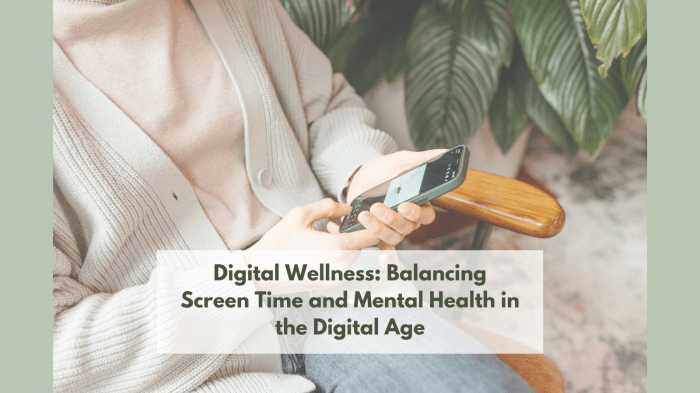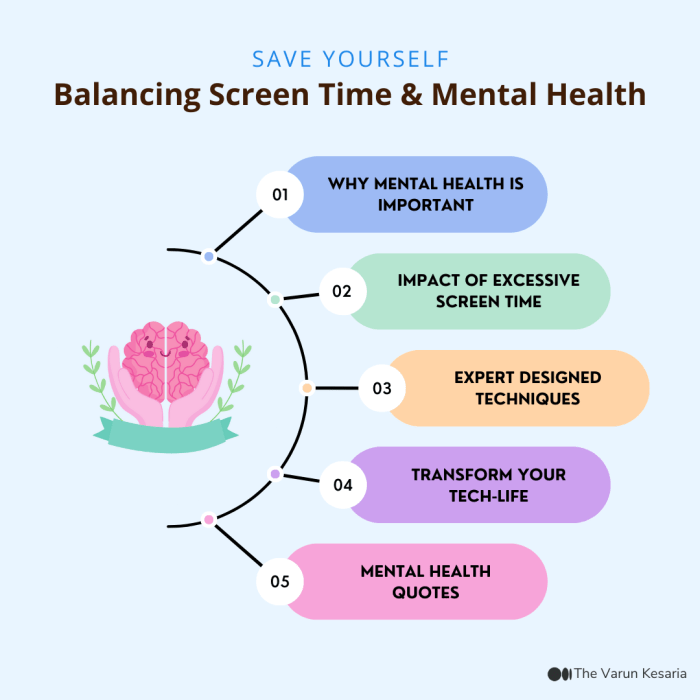Diving into the realm of Balancing Screen Time and Mental Wellness in Modern Lifestyles, we explore the delicate harmony between our digital habits and mental well-being. As technology continues to shape our daily routines, striking a balance becomes essential for a healthier mind.
Understanding the Impact of Screen Time on Mental Wellness
Excessive screen time has been shown to have a significant impact on mental health. The constant exposure to screens, whether from smartphones, computers, or televisions, can lead to various mental health issues.
Common Mental Health Issues Linked to Excessive Screen Time
- Increased stress and anxiety levels: Spending too much time in front of screens can contribute to heightened stress and anxiety due to the constant stimulation and information overload.
- Depression: Research has indicated a correlation between excessive screen time and symptoms of depression, as screens can negatively impact sleep patterns and mood regulation.
- Social isolation: Excessive screen time can lead to social withdrawal and isolation, as individuals may prioritize online interactions over face-to-face communication.
Research Findings on the Correlation Between Screen Time and Mental Wellness
Studies have found that prolonged screen time is associated with poor mental well-being, including increased feelings of loneliness, depression, and anxiety.
Research also suggests that limiting screen time and incorporating regular breaks can have a positive impact on mental health and overall well-being.
Strategies for Balancing Screen Time and Mental Wellness
In today's digital age, finding a balance between screen time and mental wellness is crucial for overall well-being. By implementing certain strategies, individuals can reduce screen time and improve their mental health.
Tips for Reducing Screen Time in Daily Routines
It is important to set boundaries and create designated screen-free times during the day. This can include turning off devices an hour before bedtime to promote better sleep quality. Additionally, setting limits on social media usage and prioritizing face-to-face interactions can help reduce overall screen time.
Techniques for Integrating Mindfulness Practices
Practicing mindfulness can help counterbalance the effects of excessive screen time on mental health. Techniques such as meditation, deep breathing exercises, and yoga can promote relaxation and reduce stress levels. By incorporating mindfulness practices into daily routines, individuals can cultivate a sense of presence and awareness.
Activities Promoting Mental Wellness
Engaging in activities that promote mental wellness can be a great way to replace screen time. Examples include going for a walk in nature, practicing a hobby or creative outlet, exercising, or spending time with loved ones. These activities not only help in reducing screen time but also contribute to overall mental well-being.
Creating Healthy Screen Time Habits

Establishing healthy screen time habits is crucial for maintaining mental wellness in today's digital age. By setting boundaries and creating tech-free zones, individuals can strike a balance between screen time for work, entertainment, and relaxation
Setting Boundaries on Screen Time Usage
It's important to establish clear guidelines for screen time usage to prevent excessive exposure. Consider setting time limits for different activities such as work, social media, and streaming services. Use apps or tools that track screen time and provide reminders when limits are reached.
Creating Tech-Free Zones in Living Spaces
Designate specific areas in your home where screens are not allowed, such as the bedroom or dining table. This helps create boundaries between screen time and relaxation, promoting better sleep and quality time with loved ones.
Establishing a Balance Between Screen Time Activities
Allocate time for work-related screen activities, leisure activities like watching movies or playing games, and relaxation activities such as reading or meditating. Prioritize activities that promote mental well-being and limit mindless scrolling or binge-watching.
Impact of Screen Time on Sleep Patterns and Mental Health

Screen time before bed can have a significant impact on both sleep quality and mental wellness. The blue light emitted from screens, such as smartphones, tablets, and computers, can interfere with our circadian rhythm, making it harder to fall asleep and stay asleep.
Relationship Between Blue Light and Disrupted Sleep Patterns
Blue light suppresses the production of melatonin, the hormone that regulates sleep, making it difficult for our bodies to wind down and prepare for rest. This can lead to insomnia, poor sleep quality, and overall sleep disturbances.
Effective Strategies for Improving Sleep Hygiene Amidst Screen Time Exposure
- Avoid screens at least an hour before bedtime to allow your body to naturally produce melatonin and prepare for sleep.
- Use night mode or blue light filters on your devices to reduce the impact of blue light on your circadian rhythm.
- Create a calming bedtime routine that does not involve screens, such as reading a book, meditating, or practicing deep breathing exercises.
- Keep electronic devices out of the bedroom to create a sleep-friendly environment that promotes relaxation and restful sleep.
Closure
In conclusion, navigating the landscape of screen time and mental wellness requires a mindful approach and conscious choices. By implementing strategies and creating healthy habits, we pave the way for a more balanced and fulfilling lifestyle in the digital era.
Essential Questionnaire
How does excessive screen time impact mental health?
Excessive screen time can lead to issues like digital eye strain, sleep disruptions, and decreased social interactions, contributing to feelings of isolation and anxiety.
What are some effective techniques for reducing screen time?
Setting specific time limits, engaging in offline activities, and practicing mindfulness can help reduce screen time and promote mental well-being.
Why is creating tech-free zones important for mental wellness?
Tech-free zones allow for uninterrupted relaxation, improved sleep quality, and enhanced focus on real-life interactions, fostering a healthier balance in our digital lives.
How can one establish a balance between screen time for work, entertainment, and relaxation?
Creating a schedule that allocates specific time for work-related screen use, entertainment purposes, and relaxation activities helps maintain a healthy balance and prevents overindulgence in screen time.



